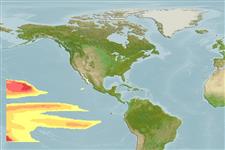>
Stomiiformes (Lightfishes and dragonfishes) >
Stomiidae (Barbeled dragonfishes) > Melanostomiinae
Etymology: Eustomias: Greek, eu = good + Greek, stoma = mouth (Ref. 45335); longiramis: Named in reference to its extremely long medial branch (Ref. 45801).
Environment: milieu / climate zone / Mức độ sâu / distribution range
Sinh thái học
Biển Tầng nổi biển sâu; Mức độ sâu 0 - 875 m (Ref. 45801). Deep-water
Eastern Central Pacific: near Hawaii, just north of Hawaii, and near the equator southeast of Hawaii.
Bộ gần gũi / Khối lượng (Trọng lượng) / Age
Chín muồi sinh dục: Lm ? range ? - ? cm
Max length : 16.3 cm SL (female)
Short description
Khóa để định loại | Hình thái học | Sinh trắc học
Barbel with five simple, tapering branches apparently arising together from main stem (lateral pair actually arising from the bases of the medio-lateral pair just distal to stem); medial branch longest, its length three times distal barbel; stem pigment extending up to terminal bulb; bulb short, barely greater in diameter than stem, bearing a single simple terminal filament (Ref. 45801).
Body shape (shape guide): elongated.
Epi- and mesopelagic (Ref. 58302).
Life cycle and mating behavior
Chín muồi sinh dục | Sự tái sinh sản | Đẻ trứng | Các trứng | Sự sinh sản | Ấu trùng
Clarke, T.A., 2001. Pelagic fishes of the genus Eustomias, subgenus Dinematochirus (Stomiidae), in the Indo-Pacific with the description of twelve new speices. Copeia 2001(3):683-699. (Ref. 45801)
IUCN Red List Status (Ref. 130435: Version 2025-1)
Threat to humans
Harmless
Human uses
Các nghề cá: không ích lợi (thú vị)
Các công cụ
Special reports
Download XML
Các nguồn internet
Estimates based on models
Preferred temperature (Tài liệu tham khảo
123201): 5.5 - 13.6, mean 7.8 °C (based on 6 cells).
Phylogenetic diversity index (Tài liệu tham khảo
82804): PD
50 = 0.5000 [Uniqueness, from 0.5 = low to 2.0 = high].
Bayesian length-weight: a=0.00302 (0.00116 - 0.00786), b=3.12 (2.89 - 3.35), in cm total length, based on LWR estimates for this (Sub)family-body shape (Ref.
93245).
Mức dinh dưỡng (Tài liệu tham khảo
69278): 4.3 ±0.8 se; based on size and trophs of closest relatives
Thích nghi nhanh (Tài liệu tham khảo
120179): Chiêù cao, thời gian nhân đôi của chủng quần tối thiểu là dưới 15 tháng (Preliminary K or Fecundity.).
Fishing Vulnerability (Ref.
59153): Low vulnerability (10 of 100).
🛈
